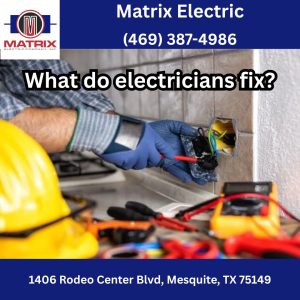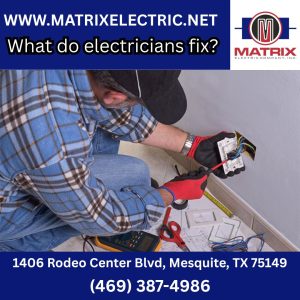Electricians fix problems with wiring, panels, circuits, outlets, lighting, and the electrical parts that keep appliances and safety systems working. If a breaker trips, a light flickers, or an outlet feels warm, a licensed electrician can diagnose the fault, repair the damaged components, and verify that your home meets code. Many homeowners in Texas see issues during summer heat and storm season, so a quick and accurate repair protects both comfort and safety. This topic matters because electricity touches every part of a house. A small mistake can lead to shocks or fire. Professional service keeps your family safe and helps major equipment last longer.

Introduction
Electricians are essential because electricity is both powerful and unforgiving. A single loose connection can generate heat and carbonize insulation. A miswired circuit can damage a refrigerator or an HVAC blower. Trained technicians know how to trace faults, test with proper meters, and correct the real root cause rather than the symptom.
Professional electrical repair versus do it yourself is about risk management and code knowledge. A homeowner can change a light bulb. Beyond simple tasks, the margin for error narrows fast. Licensed electricians work to the National Electrical Code and local requirements followed across Texas communities. That means safer outcomes, cleaner workmanship, and solutions that hold up through summer peak loads and spring storms.
Common Electrical Issues Electricians Fix
Faulty Wiring and Electrical Panels
- Outdated wiring problems. In older Texas homes, cloth insulation and aluminum branch circuits still show up during inspections. Electricians replace brittle conductors, correct neutral and ground separation, and address undersized junction boxes.
- Circuit breaker repairs and upgrades. Breakers that trip often may be responding to real overloads or to a weak device. An electrician calculates circuit load, balances legs, and recommends panel upgrades when new equipment such as EV chargers or workshop tools are added.
Lighting Issues
- Indoor and outdoor lighting repairs. From kitchen recessed cans to backyard security floods, technicians replace failed drivers, swap unsafe fixtures, and correct incorrect lamp types that overheat trims.
- Flickering lights and dimming problems. Voltage drop can appear when large HVAC compressors start, especially during a Texas heat wave. An electrician checks connections, evaluates service conductors, and installs hard start kits or dedicated circuits when appropriate.
Power Outages and Electrical Surges
- Diagnosing causes of sudden power loss. Localized outages often trace to a failed breaker, a loose neutral, or a damaged feeder. A pro will isolate the affected branch, test continuity, and repair burnt terminations.
- Surge protection installation. Lightning and grid events can introduce harmful spikes. Whole home surge protection at the main panel and point of use devices help protect electronics, smart thermostats, and garage door openers.
Switches and Outlets
- Repairing broken outlets and switches. Cracked devices, worn contacts, and backstabbed connections create intermittent failures. Electricians replace devices, pigtail conductors, and secure terminations.
- Installing new GFCI outlets for safety. Kitchens, bathrooms, garages, and outdoors need GFCI protection. A technician verifies correct line and load wiring and tests trip response with a calibrated tester.
Appliances and Home Systems Electricians Service
Kitchen Appliances
Ranges, ovens, cooktops, and refrigerators depend on solid power delivery. A common example is a range on a worn receptacle that arcs under load. The fix is a fresh receptacle, correct gauge conductors, and a torque check on lugs. For refrigerators that trip a GFCI, an electrician evaluates nuisance trips, circuit location, and code allowances for dedicated circuits.
HVAC and Water Heaters
In Texas, cooling is mission critical. Electricians service disconnects, whip connections, and breakers that feed condensers and air handlers. They confirm that the condenser is on the correct breaker size with the manufacturer nameplate as the guide. For water heaters, technicians replace burnt elements, correct bonding, and verify that the disconnect is within sight where required.
Smart Home Systems
Smart lighting, doorbells, cameras, and thermostats change how power and data share space. Electricians install low voltage transformers, correct polarity, and ensure that neutral availability matches device requirements. They also solve phantom loads and dimmer compatibility issues with LED lamps.
| Homeowner Symptom | Likely Electrician Action |
|---|---|
| Lights dim when AC starts | Measure voltage sag, tighten service lugs, balance loads, consider hard start kit |
| Outlet warm to the touch | Open device, replace worn receptacle, move from backstab to screw terminals |
| Breaker trips on microwave use | Check circuit amperage and wire size, add dedicated small appliance circuit |
| Frequent bulb failures in garage | Verify vibration rated lamps, inspect neutral, confirm fixture wattage rating |
| Doorbell camera drops offline | Test transformer voltage, correct polarity, separate power and data routes |
- The same symptom can have several root causes, which is why testing matters.
- Load calculations prevent nuisance trips and protect equipment life.
- Texas heat amplifies weak connections due to thermal cycling.
- Storm season brings surges that benefit from layered protection.
- Upgrading parts the right way once is cheaper than repeat callbacks.
Safety and Code Compliance Work
Electrical Inspections
- Ensuring systems meet safety standards. Electricians perform panel audits, label circuits, and check that bonding and grounding meet code.
- Pre purchase home inspection support. Buyers in Texas often request an electrical review alongside a general inspection. A licensed electrician provides a punch list that prioritizes safety items like double tapped breakers and missing GFCI protection.
Upgrades for Older Homes
- Rewiring. Knob and tube may still be present in very old structures. Technicians design a plan that minimizes wall damage, adds proper junction boxes, and replaces brittle conductors with copper branch circuits.
- Upgrading panels to handle modern load. Many houses that started with smaller services now run EV chargers, home offices, and workshop tools. An evaluation may lead to a larger service, new main bonding, and arc fault or ground fault protection where required.
Specialized Services Electricians Offer
Emergency Electrical Repairs
- When to call immediately. Call right away if you smell burning insulation, see smoke from a device, or hear loud buzzing from a panel. Safety comes first.
- Common urgent scenarios. Weather related surge, water intrusion at an exterior receptacle, or a main breaker that will not reset. An electrician will secure the area, restore safe power, and plan permanent repairs.
Commercial Electrical Services
- Office wiring and electrical maintenance. Businesses need clean power for computers and point of sale systems. Electricians install dedicated circuits, surge suppression, and emergency lighting that supports safe egress.
- Industrial equipment servicing. Three phase systems, motor starters, and control circuits require specialized knowledge. A licensed pro verifies overcurrent protection and conductor sizing to match motor loads.
When to Call an Electrician vs DIY
Signs You Should Not Ignore
- Buzzing outlets or switches
- Warm cover plates or scorched marks on devices
- Frequent breaker trips or GFCI resets
- Flicker that does not track with lamp replacement
- Shocks when touching an appliance or a metal sink
Why DIY Can Be Dangerous
Electricity leaves little room for guessing. Without the right tools and training, it is easy to over tighten a lug, nick a conductor, or misidentify a neutral. Each mistake can create heat or expose live parts. Licensed electricians use torque specifications, insulation ratings, and test instruments that validate the repair. That is the difference between a short term workaround and a solution that keeps working under summer load and winter storms across Texas.

Conclusion
Electricians fix wiring, panels, lighting, outlets, surges, and the power behind appliances and smart devices. They also perform safety inspections, code upgrades, and emergency work that restores safe service. In Texas, where heat and storms stress electrical systems, a trained technician is the best safeguard against shocks and fires. If you are asking what electricians fix, the accurate answer is that they handle the full path from the service entrance to the final device while putting safety and code compliance first.
Matrix Electric Company Inc. focuses on practical, code based solutions that last. For more information or to discuss your situation, you can explore more by visiting the company website at https://www.matrixelectric.net/. A clear plan, careful testing, and professional workmanship will keep your home safe and ready for the next season.

